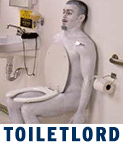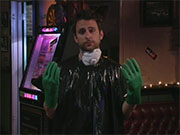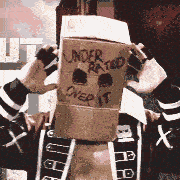|
I'm doing a project for university where I need to design a error-proofing system to prevent costly mishaps in industry (could be literally any industry). This could be anything from defective products that cost the company money to return and replace, to lost stock or lost customers, or even just downtime, literally any time a mistake costs your business money is of interest to me. The more money it costs and the more frequently made the mistake, the better.
Cymbal Monkey fucked around with this message at 21:15 on Aug 1, 2017 |
|
|
|

|
| # ? May 5, 2024 22:58 |
|
A lot of companies that distribute private labeled consumer goods don't realize words have meaning or the specific triggers and requirements for safety statements in the US. Like "DANGER, WARNING, or CAUTION" and when you can or can't use them. So idiots in sales and marketing will tell their art guys to just use "caution" as their signal word, or not use such scary language like "extremely flammable," or "severe eye irritant," try and shrink and hide the text, or just plain skip the statements. Since the CPSC is woefully understaffed and doesn't have a big enforcement branch, (or OSHA for workplace when it comes to reviewing items used) this usually flies under the radar until A. Someone gets hurt B. A competitor sees the unfair advantage the label provides and reports them The cost depends on the product, and how mislabeled it was and for how long or if anyone got hurt. The usual formula's base includes estimating how much extra revenue the company got from the unfair advantage/mislabeling or what it saved them in cost vs a company that obeyed the law -and fining them that in the entirety. So if you made an extra 2 dollars a widget and sold 10,000 widgets improperly labeled, the fine would start at $20,000. -A big scary number, but especially if no one is hurt, if you don't go to a hearing you can settle and get a 40% - 75% reduction. Then from there, you'd have recall and disposal costs, or if possible added packaging/replacement art or instructions. From there you'd probably also have to issue credits or repay those customers for their labor (Wal-Mart is not going to eat the cost of their staff pulling an item off the shelves and replacing art or stickering every sku for example). So companies that are on the ball usually try to avoid those mistakes or fix them before their product is out in the wild. A quick example I can think of is a cleaning product packager I worked with when OSHA rolled out its new GHS hazard icon law a few years ago. They didn't realize the icons had color requirements for each element, and printed them black and white on their labels. This was luckily caught on their end before any regulators saw it and before anything hit retail shelves, but they had to throw out stock of about 20k labels (at 10 cents a pop) and also had to mail out stickers to cover the improper icons to a customer that cost them about 5 cents a pop to replace, for about 500 4 packs -so 2k stickers. That was a small enough vendor to just grumble and do it himself without charging them. A bigger vendor could have easily refused shipment, or fully sent them back. Or if they really wanted to be dicks, have it returned/hauled back as hazardous waste. So a very frequent mistake that can be very costly but it's a lottery in terms of enforcement or actually paying that cost. Coolness Averted fucked around with this message at 11:35 on Aug 2, 2017 |
|
|
|
That's exactly the sort of thing I'm looking for because it has clear costs and I feel like it would be very easy to deal with in software with a computer-guided warning generator so that no matter how simple the guy drawing the labels is they'll be able to generate warning labels in compliance with the law. Thanks.
|
|
|
|
Cymbal Monkey posted:That's exactly the sort of thing I'm looking for because it has clear costs and I feel like it would be very easy to deal with in software with a computer-guided warning generator so that no matter how simple the guy drawing the labels is they'll be able to generate warning labels in compliance with the law. Thanks. Yup! If you need actually 'solve' this problem and can't just model it/make your own example categories you can google "GHS purplebook" or "OSHA GHS labeling guidelines" or "OSHA GHS hazard guidelines" to get the stuff broken down. It can be thick but lays out exactly "This triggers this, which needs the following text and pictograms" the place I'm at now uses software solutions that's pretty much just a database check right now to do exactly what you're talking about. You click boxes for hazards, ingredients and stuff like flammability or pH range and it automatically spits out what's needed for the safety data sheet -which in turn in the template for the label too. Good luck on your project.
|
|
|
|
Coolness Averted posted:Yup! If you need actually 'solve' this problem and can't just model it/make your own example categories you can google "GHS purplebook" or "OSHA GHS labeling guidelines" or "OSHA GHS hazard guidelines" to get the stuff broken down. It can be thick but lays out exactly "This triggers this, which needs the following text and pictograms" the place I'm at now uses software solutions that's pretty much just a database check right now to do exactly what you're talking about. You click boxes for hazards, ingredients and stuff like flammability or pH range and it automatically spits out what's needed for the safety data sheet -which in turn in the template for the label too. That's somewhat frustrating, if there's a common existing solution that kinda fucks me. Hmm I wonder how this could be improved.
|
|
|
|
I work in residential construction and there are a lot of houses that need their carpets refitted.
|
|
|
|
I work in logistics and transportation. It's amazing how many things I can't deliver because of a signature requirement to a residence (during business hours, of course) or an incomplete address (maybe a name but no business name or suite number for a downtown office building). I don't work in management so I don't have numbers, but 9 times out of 10, it costs a retail center $10 to get an item delivered from them to anywhere (another center, a customer, etc) within 40-50 miles in standard business hours. If the recipient is closed, isn't home, or the address isn't complete, I mark it as Bad Address/Resident Not Home, and the package usually gets sent to a relay station, where it sits overnight at least. The next day someone will pick the item up and send it back to the original sender. There is no cost for the return, but the customer doesn't have their ordered item/the store didn't get the supplies they needed to complete an order, and everything is a day behind. So say the address is fixed, but someone messes up the numbers. Suite 16 instead of 61. The store pays another 10 for the next delivery, and we see a repeat of above. A single order averages 1-2 fuckups after the first initial one. Keep in mind we service about 30 main centers and dozens of customers a day. Now add in the Expedited orders, the ones with a 2 or 3 or 4 hour due time. Which is why no one has any real time to call a center and clarify the address; it's literally in an out in under 5 minutes per delivery (which can be 10-15 car tires, wheelchairs, small boxes of paper, etc). When we get overloaded, third party couriers are called in....which are nowhere competant. The added cost of hiring out to finish some orders means the order often never arrives or gets left at the wrong address, so orders have to be made up again fast, and often with Expedited service which can range from 2-5x more the standard rate.
|
|
|
|
Macarius Wrench posted:I work in residential construction and there are a lot of houses that need their carpets refitted. Secondhand, but my father-in-law works for an architecture firm and it's astonishing how often nobody notices an important feature was left off the blueprints until the building is 90% done. Missing wiring and air ducts etc. are commonplace and are usually straightforward if messy to fix after the fact, but sometimes architects leave out structural design features like expansion joints or firewalls and then the poo poo really hits the void in the building where there was supposed to be a fan.
|
|
|
|
Cymbal Monkey posted:That's somewhat frustrating, if there's a common existing solution that kinda fucks me. Hmm I wonder how this could be improved. Well, there are some off the shelf solutions, but most have a 100k or so annual license (we built our database ourselves) so some manufacturers use them, but you'll rarely see a company buying private labeled products buying that kind of software solution. So you can use that as an angle. Plus the software generates an SDS which we then read to make a label. You could cut out that step and just do label guidance.
|
|
|
|
Coolness Averted posted:Well, there are some off the shelf solutions, but most have a 100k or so annual license (we built our database ourselves) so some manufacturers use them, but you'll rarely see a company buying private labeled products buying that kind of software solution. So you can use that as an angle. Plus the software generates an SDS which we then read to make a label. You could cut out that step and just do label guidance. That's perfect, sounds very manageable. Luckily I don't have to get too in the weeds about the legal aspects, I just have to write a proposal.
|
|
|
|
I work in the entertainment industry, and most of my work product is overseen by a regulatory organization with very precise and clearly documented labeling requirements. There are several layers of otherwise responsible, qualified people on every project whose job it is to make sure all the content, legalese etc is exactly what it's supposed to be. I'm at the very end of the production pipeline before publication, and it's frightening how often we publish or nearly publish materials that aren't compliant with our regulatory body's requirements. I can say without exaggeration that I've saved my company tens of thousands of dollars in the past few years by noticing violations that weren't caught by the people paid to do so. I don't have precise numbers for our competitors in the industry, but I understand that we're on the low end in terms of violations. I can't imagine the mess at companies toward the higher end, since the fees increase with every violation during a calendar year.
|
|
|
|
Guest Respirator posted:I work in the entertainment industry, and most of my work product is overseen by a regulatory organization with very precise and clearly documented labeling requirements. There are several layers of otherwise responsible, qualified people on every project whose job it is to make sure all the content, legalese etc is exactly what it's supposed to be. Do you mean things like correct credits and copyright info and such?
|
|
|
|
Straight White Shark posted:Secondhand, but my father-in-law works for an architecture firm and it's astonishing how often nobody notices an important feature was left off the blueprints until the building is 90% done. Missing wiring and air ducts etc. are commonplace and are usually straightforward if messy to fix after the fact, but sometimes architects leave out structural design features like expansion joints or firewalls and then the poo poo really hits the void in the building where there was supposed to be a fan. The transportation consultants I work for do a respectable chunk of their annual business in "this road / runway / maaaaybe bridge is hosed up, whose fault is it and how much do they have to pay". If I had to go off the cuff I'd say it's most commonly the construction contractors messing up / getting lazy / trying to pull a fast one, but you bet your britches there are design errors too.
|
|
|
|
I'm an anesthesiologist. I don't know the statistics, but I suspect one of the most common important errors that happen in my setting are drug swap/medication errors, when a medication other than what was intended (or wrong dosage) is administered to a patient. Almost all of the drugs we use are clear liquids, indistinguishable from each other. We check the name and concentration of the drug on the vial and whether it's expired, and then draw it into an appropriately labeled syringe and check the vial against the syringe as we draw it up. Then we only have the syringe and its label for reference. Propofol is the only drug that looks different, it is white and opaque like milk. The sources of error could include -Original pharmacy mislabeling the vial (this is probably the most rare type of error). -Drawing up the wrong drug into the vial, either due to inattention, picking up a vial with similar appearance and label but different drug that happened to get stocked into the same drawer as the intended drug (stocked wrongly also because of its appearance), a moment's distraction while in the act of drawing up the drug, etc. -Drawing up and labeling the syringe properly but administering from the wrong syringe, either due to being in a hurry, etc. -Dark operating rooms or other environments such as during arthroscopic or laparoscopic procedures where the surgeon views the procedure through a video monitor or on a radiology screen, thus wanting a darkened room, making it harder to read labels. It used to be common in operating rooms when certain substances were used, like radiographic contrast dye, they would be identified by the surgical technologist and placed on the operating area in an unlabeled cup or syringe. As you can imagine there have been a number of instances where the wrong substance was administered, sometimes with catastrophic results. Now it's pretty much the standard that these items have to be properly labeled also, although it still doesn't eliminate the other sources of error listed above. System approaches to eliminate this type of error: -Syringes premade and labeled in pharmacy. Error is still possible but it eliminates the step of an anesthetist transferring drug to syringe and labeling improperly. -Color coding of labels for different types of drug. Of course if one gets too accustomed to this and relies to heavily on it it can cause its own type of error. -Having two people check the drug label before administration. This type of procedure is routinely done before administration of blood products. It's my understanding that in some countries this is regularly done. In the current culture of American operating room medicine, it's difficult for me to imagine this practice taking hold due to the time it adds (multiply a the time for this check for a million medication administrations) and the cost of the extra manpower. -Making sure the people administering medications have adequate light to read the labels in the work environment There's plenty of types of error that happen in my environment but due to the sheer number of medication administration events, I suspect this has got to be one of the most common ones with potential major consequence.
|
|
|
|
Cymbal Monkey posted:Do you mean things like correct credits and copyright info and such? Sorry for the vagueness! I mean content ratings. MPAA for movies, ESRB for games, etc.
|
|
|
|
Cutting your climbing line and falling 50 feet into a broken femur/broken back/death. Getting pulled into a woodchipper. Incorrectly roping a log and having it plunge through the roof of a multi-million dollar home. These are the worst possibilities and quite rare though. More common: putting logs through truck windows, riding with parking brakes engaged, running over a chain saw...just breaking equipment at $1000.00 a pop really adds up. Someone with the capacity and know-how to work 10-12 hour days in the heat: very hard to find. Will that same individual likely break something at least once a month? Ya.
|
|
|
|
Straight White Shark posted:Secondhand, but my father-in-law works for an architecture firm and it's astonishing how often nobody notices an important feature was left off the blueprints until the building is 90% done. Missing wiring and air ducts etc. are commonplace and are usually straightforward if messy to fix after the fact, but sometimes architects leave out structural design features like expansion joints or firewalls and then the poo poo really hits the void in the building where there was supposed to be a fan. Wasn't that long ago I read an article where they had to tear up the entire foundation for a Walmart Supercenter because they read the plans backwards, and all the HVAC, wire runs, and plumbing runs in the foundation were reversed front to back.
|
|
|
|
Cymbal Monkey posted:I'm doing a project for university where I need to design a error-proofing system to prevent costly mishaps in industry (could be literally any industry). This could be anything from defective products that cost the company money to return and replace, to lost stock or lost customers, or even just downtime, literally any time a mistake costs your business money is of interest to me. The more money it costs and the more frequently made the mistake, the better. Focus 100% on physiological and psychological human factors. Every incident boils down to one of two scenarios: A: Written procedures failed to cover every possible contingency and a situation inevitably arose in which guidance was vague and inadequate B: Written procedures were ignored. The causes of B are overwhelmingly complacence and fatigue. Manufacturing is HARD. shame on an IGA fucked around with this message at 21:08 on Aug 7, 2017 |
|
|
|
Case in point, this is the example we use for new hire orientation that actually happened: We make needle bearings. One day the assembly line gets an order to change over and run part number, say, F-294545.XU 231-12 The supervisor goes to the file cabinet and pulls the setup sheet, prints, control plan, and inspection procedures for F-294545.KU 231-12 and places them at the appropriate work stations. Packaging and shipping draw their information from the shop order traveler on the parts after they're finished, which reads F-294545.XU 231-12, labels them as such, and ships them to the distributor. All the components and dimensions are identical. The only difference is that F-294545.KU isn't pre-lubricated by us at the factory, it's a specialty part for one customer who uses a hilariously expensive grease that they source and apply themselves. This run of dry bearings ships to the distributor having met all of the (incorrect) specifications that were provided at every step of the production process. A few days later corporate gets a call from GM. Further investigation reveals the distributor had already shipped the batch to multiple customers. We issue a recall. The distributor issues a recall GM issues a recall John Deere issues a recall Harley Davidson issues a recall We are on the hook for all of the parts, all of the labor for all of those customers to manually inspect and cull the date codes on their entire inventories of this part, and several hours of complete shutdown at John Deere's factory. One transcription error by someone pulling a file out of a cabinet compounded by multiple operators failure to verify the documentation P/N against the shop order P/N cost Twelve Million USD. This despite the 40+ year standing rule that every operator must perform that documentation check and sign off on it at every shift change and every shop order changeover on pain of first-offense termination. shame on an IGA fucked around with this message at 21:37 on Aug 7, 2017 |
|
|
|
shame on an IGA posted:This despite the 40+ year standing rule that every operator must perform that documentation check and sign off on it at every shift change and every shop order changeover on pain of first-offense termination. How many people got housecleaned?
|
|
|
|
Software development industry. SQL injection is the bane of our existence. Software needs to store stuff for later retrieval. This stuff goes into a database. Most databases use a common language called SQL. A SQL statement looks like this: SELECT Column1, Column2 FROM SomeDataLocation WHERE SomeFilterCriteria='A Value' It's pretty straightforward: Look at this location, give me back the data I'm looking for where some set of criteria is met. This becomes a problem when these statements are generated by slapping user input directly in the middle of the statement. Let's say we want to pull back a user's name when they give the right username and password. The naive way to do it would look like this: "SELECT FirstName, LastName FROM Users WHERE UserName='" + UserName + "' AND Password='" + Password + "'" If I entered my username as "New Yorp" and my password as "buttslmao", this is say "Build up a query that says "SELECT FirstName, LastName FROM Users WHERE UserName='New Yorp' AND Password='buttslmao' However, what if I entered my password as dongs' OR 1=1? Well, that query would look like this: "SELECT FirstName, LastName FROM Users WHERE UserName='New Yorp' AND Password='dongs' OR 1=1 If I were using that for checking if a login is valid, suddenly, I could log in for ANY user account as long as I had a username. Doesn't matter that I put the wrong password in, the OR 1=1 changes the query to say "the password has to match or 1=1 has to be true." You can even go further from there and craft injectable statements to do malicious things, including deleting data or retrieving data you shouldn't be able to see at all. Every programming language that interacts with databases has native, easy ways to prevent this from occurring, but it's still the most common security flaw around. Why? Because people don't know any better. SQL injection is responsible for security breaches time and time again, at companies both large and small.
|
|
|
|
Teaching Split classes (Ex: Grade 7/8 Social Studies) just getting taught one grade, e.g. teaching only Grade 8 Social Studies to both the Grade 7's and 8's. This means that students will miss stuff that is fundamental to learning concepts in following years. I only know a few teachers who do this, most just teach a combination of both grades, at least for English and Social Studies, but the ones who just lie (you have to comment on set outcomes for each course, and if you aren't assessing those outcomes it means you're putting in fake grades for them) and skip years are constantly juggling and pissing off Senior High teachers when they tell them they need to cover Middle School stuff because x group wasn't taught y, which puts those teachers into a bind because there is very little time to cover your own outcomes, let alone the ones some other teacher didn't cover because they didn't want to put the effort in plus you are really not supposed to teach outcomes not covered in your classes. Professor Shark fucked around with this message at 17:44 on Aug 8, 2017 |
|
|
|
Professor Shark posted:Teaching Oh man my middle school adopted this and it was a loving disaster.
|
|
|
|
For English they work out fine- English outcomes are pretty similar in Middle school and Senior high, however aside from curriculum difficulties, in my experience classroom behavior tends to be more of a challenge compared to a non split class.
|
|
|
|
shame on an IGA posted:One transcription error by someone pulling a file out of a cabinet compounded by multiple operators failure to verify the documentation P/N against the shop order P/N cost Twelve Million USD. This despite the 40+ year standing rule that every operator must perform that documentation check and sign off on it at every shift change and every shop order changeover on pain of first-offense termination. To be fair depending on how old the print is (typewriter?) I've seen some very similar... I thought there was some kind of guide written by someone somewhere that said what letters to avoid... Off the top of my head... K and X 5 and S I(EYE) or lower case 'L' or 1(one) 6 or G 8 or B If you can't get good light on it 'T' and '7' might be problematic too... Other mistakes: -Client changing the oil on an emergency diesel engine for the plant air compressor, forgot to replace the oil after draining it. Destroyed the diesel engine and coupling upon re-start. (100 quarts of oil does not just 'disappear') Around a million dollars or two. -I send you a pm on the second one, substantial cost. Senor P. fucked around with this message at 03:03 on Aug 15, 2017 |
|
|
|
One interesting thing that's been coming up more and more in medicine is the problem of alert overload and fatigue - basically, systems that are supposed to help doctors and medical staff recognize potential mistakes are covering them up instead. Basically, as electronic medical records were rolled out, there were big pushes to add in automatic alerts that would tell doctors about potentially dangerous treatments, drug interactions, and so on. But, in medicine, practically everything carries some risk. Hospitals and EMR (electronic medical record) vendors certainly don't want to be liable, so they made sure to alert on any possible problem. A lot of them are irrelevant (oh dear, this 90 year old patient doesn't have any record of a childhood MMR vaccine!) and basically just train the staff to dismiss them automatically. When the actually serious warnings pop up, they get dismissed out of habit, too. The net impact of the alert system is neutral or even negative. As a bonus, "alert fatigue" is a recognized but difficult problem, with lots of literature in both popular media and scientific journals, and analogous issues in every safety-critical industry from aviation to nuclear power.
|
|
|
|
Space Gopher posted:One interesting thing that's been coming up more and more in medicine is the problem of alert overload and fatigue - basically, systems that are supposed to help doctors and medical staff recognize potential mistakes are covering them up instead. Solution: stop caring about any liability short of criminal negligence, just tax everyone (but especially the rich/corporations) a bit more and use the taxes as a national insurance for absolutely loving everything.
|
|
|
|
Space Gopher posted:.... Yeah, as I read this post I thought of Three Mile Island and multiple episodes of Air Disasters. I've also read articles about sign overload. As in there being so much signage on some roads it actually makes people less safe because they're scanning all the drat signs instead of the other vehicles.
|
|
|
|
Musician. There are three basic categories of costly mistakes that are normal in our business Costly mistakes caused by musicians: gear mistreated, stored in stupid ways that gets it broken or stolen, substance abuse, the occasional trashed backstage or hotel room. typically a few hundred to a couple thousand dollars (though occasionally substantially more especially if the problems lead to cancelled shows) Costly mistakes caused by venues and tech crews: stages collapsing, lights falling, speakers blowing out, fires, serious injuries, deaths. much more rare than the former but the damage can be in the tens to hundreds of thousands. this was the reason for Van Halen's infamous "brown m&m clause" in their rider Costly mistakes caused by record labels botching the transition to digital media: millions
|
|
|
|
blowfish posted:Solution: stop caring about any liability short of criminal negligence, just tax everyone (but especially the rich/corporations) a bit more and use the taxes as a national insurance for absolutely loving everything.
|
|
|
|
Thanatosian posted:This removes a lot of the incentive to mitigate. Having incentives stacked in favour of any mitigation no matter how inconsequential and useless is obviously also leading to problems - you want to incentivise mitigation measures only if they improve results on aggregate, with a penalty for redundant/useless poo poo.
|
|
|
|
Space Gopher posted:One interesting thing that's been coming up more and more in medicine is the problem of alert overload and fatigue - basically, systems that are supposed to help doctors and medical staff recognize potential mistakes are covering them up instead. Thank you for talking about this. We recently had this problem where I work and I couldn't recall the appropriate term.
|
|
|
|
Oops wrong part number sucks so hard. I made a very complicated part at work a while ago (mill), it then went to heat treatment, came back, got ground, jig ground, and wire edm. Passed inspection and got shipped to the customer, who promptly rejected it. We made revision a, they were on revision b. Probably 50 man hours gone, total remake of the part, messed up our schedule and was late. Wrong print followed the part around from start to finish. Nothing close to the bearing story though.
|
|
|
|
I'm a therapist. Beyond clinical errors (which are a Whole Nother Thing), the most costly mistakes happen when an insurance company audits your books, sees a problem, and demands their money back. The most common problem is that the date on your notes doesn't match the date you wrote down in your chart ledger, usually because you weren't paying attention. Using the incorrect CPT code (the code that tells the insurance company how long the session was and who was present) can also screw you over. Since each insurance-paid session runs about $65 bucks, how badly this fucks up your practice depends on how often this happened. Large practices can easily lose 10 grand in an audit if their therapists have been careless. Practice management software largely resolves this issue, but if you're lazy you can still get screwed.
|
|
|
|
I've been working in broadcast media since 2010. During one of my early job I had as an Assistant Editor for commercials I was asked to sit with the client and make any minor adjustments they wanted. The cut was essentially 'locked' meaning that 'this sequence of shots are to be processed for Online' plus 2-second handles on each shot. Commercials back then were still shot on 35mm film (transferred to DigiBeta!) so making sure that the shots in the locked cut AND ONLY the shots in the locked cut are sent off for Coloring/Mixing/Conform. Traditionally we also provide 2-seconds of handles which are the frames before and after each selected shot. For this 'spot' I was working on was a :30 second and a :15 second lift. You probably seen a commercial and then one that's longer or shorter. Those are usually :60/:90/:15 but a LIFT is when the shortened version is derived 100% from shots used in a longer version. Think of it like, "we already finished this part - so let's just reuse a smaller part of it and call it a new spot" - easy peasy. Now back to the spot I was working on. It involved slow-motion footage AND green screen comps (to put images on the t.v. screens in the spot). The client asked if I could extend a shot "just a smidge." So off I go to do just that. I find the clip the client referred to and slightly tweaked it and added about 5 frames. Lifts are supposed to be 100% lifted but you can get away with slight retimings by a handful of frames. They are most likely in the 2-second handles so everybody should be nice and happy. Until I get a call from our Flame Artist around 9PM who is doing the Final Conform and rotoscoping tv screens. They invite me into their suite and show me the shot they are working on - it's the shot I added 5 frames too. He then shows me 45 seconds of black, "this is what I'm missing" I need to work about 4 more hours on this. I didn't understand at first until he said, "this was speed changed wasn't it?" I hosed up. I thought I was only adding 5 frames of footage. The footage was speed changed to play faster by about 300% since it was shot on a Phantom (super slow mo camera). By adjusting it 5 frames I really added 45 seconds. On top of that - I then got chewed out by my EP since I didn't realize the reason why LIFTs exists in the first place. If you're an actor and you are hired for a commerical. Part of your contract is to get paid based on how many spots are made from your performance. If your shoot makes a :30 and a :60 then the actor gets paid for both performances. But if it's a LIFT it's the same performance according to lawyers - and the actor only get's paid for one performance - no matter how many lifts can be made. So my tiny mistake rippled and caused around $15,000 of lost profit which isn't even including the lost cost the flame artist had to literally eat just to get the conform done on time. Could have been drastically more if the talent was someone super famous.
|
|
|
|

|
| # ? May 5, 2024 22:58 |
|
I'm a photographer. Common mistakes include: Under-pricing. So many people will work for less than they should just to have people in the door. It's a good idea to build up the portfolio when you're starting out, but shouldn't be a habit. Over-pricing. It's one of the rare industries where someone can walk out of their college photography class, start a website and ask four grand for their first wedding. Not allowing enough time. It can take time to round up a group of fifteen people to get into a limo. If you're running late on the formal photos, then the hall is left trying to keep food warm, the guests are milling around and it starts the evening off bad. Overcomplicating: Your client might like a ton of photos on pinterest and want them replicated, but if you've got a large group and a small amount of time, or very bad weather, sometimes those tricky shots just aren't viable. Getting spun up in the drama: I don't care why Aunt Susan isn't talking to Cousin Mikey. Get in the picture. On something like a wedding, or even a family sitting, people can get bent out of shape about lipstick or clothing being the wrong colour. It's important to not play into that sort of thing and mitigate the high strung emotions as much as possible. Costly mistakes: Being too rough with the gear. Even misplacing gear. Also, hated foe gravity, because nothing's quite so horror-inducing as dropping your lens when you're switching out.
|
|
|























 I CANNOT EJACULATE WITHOUT SEEING NATIVE AMERICANS BRUTALISED!
I CANNOT EJACULATE WITHOUT SEEING NATIVE AMERICANS BRUTALISED!









